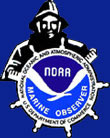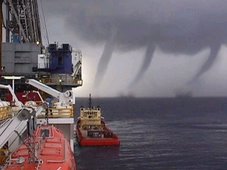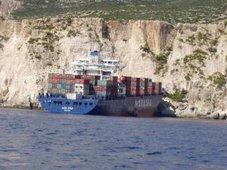 Marine Chemist Says 'Not So Fast' To Quick Oil Detection Method
Marine Chemist Says 'Not So Fast' To Quick Oil Detection MethodScienceDaily (Jun. 2, 2008) — A new method for assessing environmental contamination after oil spills is in danger of being applied in situations where it doesn't work and might produce false conclusions, a scientist at Woods Hole Oceanographic Institution (WHOI) has warned.
Private firms and government agencies have recently started using long strands of absorbent polypropylene snares, also called “pom-poms,” as a means to check for contamination of the seafloor in the wake of an oil spill. The method is becoming popular because it is rapid and low-cost.
But according to WHOI marine chemist Christopher Reddy, the approach may give a false sense of security. In a recently published letter to the Marine Pollution Bulletin, Reddy notes that while the pom-pom method is effective in locating areas where excessive amounts of oil have sunk to the bottom, it does not necessarily identify the fractions and compounds of oil that can linger in sediments and have long-term impacts on ecosystems and public health.
Following a 2004 oil spill in the Delaware River, emergency response crews employed the new pom-pom method to quickly determine the locations of large oil patches on the river floor. The information was invaluable for the emergency response and cleanup.
After the M/V Cosco Busan oil spill in San Francisco Bay in November 2007, the pom-pom method was used again. But this time, the goal was to determine if sediments near the Port of Oakland were safe to be dredged and re-used in restoration projects.
“This approach is flawed,” Reddy wrote. “It relies on the assumption that the lack of visible oil on the snares…indicates a total lack of oil contamination in the sediment…While testing of sediments with snares delivers rapid, low-cost data, it is only an indicator of gross contamination.”
“Before this approach becomes standard practice for determining whether sediments have been contaminated at levels that may impact ecosystems,” Reddy added, “prudence dictates much more rigorous testing of the test itself.”
Funding for this research was provided by the Richard and Rhoda Goldman Fund and the WHOI Coastal Ocean Institute.WEATHER NOTE
Disaster Response Imagery Ample, but Distribution Still Tough
By Peter B. De Selding, Berlin
Space News Staff Writer
The Myanmar cyclone and Chinese earthquake disasters demonstrated that the world has plenty of imaging satellites to monitor disasters but is still unable to make imagery and other data easily and widely available to emergency-response teams, government officials said.
The supply of imagery continues to grow. Italy's Cosmo-Skymed and Germany's TerraSAR-X radar satellites both contributed imagery to the relief efforts following the recent catastrophes in Myanmar and China. In terms of what is available, government officials said the combination of those two satellites, along with Canada's Radarsat, has made radar imagery nearly as easy to obtain as optical imagery. "Today we can no longer complain about the Earth observation infrastructure," said Delilah Al Khudhairy, head of the Institute for Protection and Security of the Citizen at the European Union's Joint Research Center in Ispra, Italy. "There is an overwhelming amount of product available. What we need is to facilitate the tasking of the data. It needs to be more user-driven."
In presentations here May 27-28 during the Berlin air show, ILA 2008, Al Khudhairy and other government officials said the International Charter for Space and Major Disasters, created in 1999 to coordinate satellite operators' response to natural catastrophes, needs to be made more responsive.
Charter members include the European Space Agency and the national space agencies of Argentina, Britain, Canada, China, France, India, Japan and the United States.
The charter has been activated 175 times since 1999, most recently May 12 when China, as a charter member, called on charter assistance following the earthquake in Sichuan province, according to figures compiled by the French space agency, CNES.
Because Myanmar authorities were reluctant to call on global assistance, the charter was activated by the United Nations (U.N.) to respond to that nation's cyclone disaster.
David Stevens, of the U.N. Office of Outer Space Affairs and a coordinator of the U.N. Space-based Information for Disaster Management and Emergency Response, or Spider, program, said the two Asian disasters illustrate the danger of a duplication of effort among response teams turning imagery into usable maps for relief worker. READ>
Last dance for Riverdance ferry

The next step is to set to work on removing the bow section of the stricken vessel.
Riverdance webcam
Riverdance picture gallery
Rosie Tapping, spokeswoman for the Maritime and Coastguard Agency, said: "We are content with the progress that is being made concerning the salvage of the vessel, which is continuing steadily thanks to the fair weather and good team effort from the salvage and demolition workers.
"Currently parts of the stern are being cut off and the intention is to remove the steering gear later today. The bow section will also be cut away over the next few days."
Heysham-based demolition experts Hancock's Contractors were appointed in April to undertake the salvage operation after a series of different attempts to re-float the vessel failed.
Two months of efforts to move the Riverdance were sabotaged largely by bad weather.
Hancock's put together a detailed plan of action which has included removing the remaining cargo, before tackling the upper decks and finally the hull of the boat.
The work, being carried out between tides, is due to be completed by the end of June. Hancock's has pledged to reinstate the beach and Promenade once the salvage operation has been completed.
Riverdance has attracted thousands of people to the coastline at Anchorsholme since she ran aground on February 1 during a storm. Emergency services managed to get all crew and passengers safely off the vessel.


































































































![Validate my RSS feed [Valid RSS]](valid-rss.png)